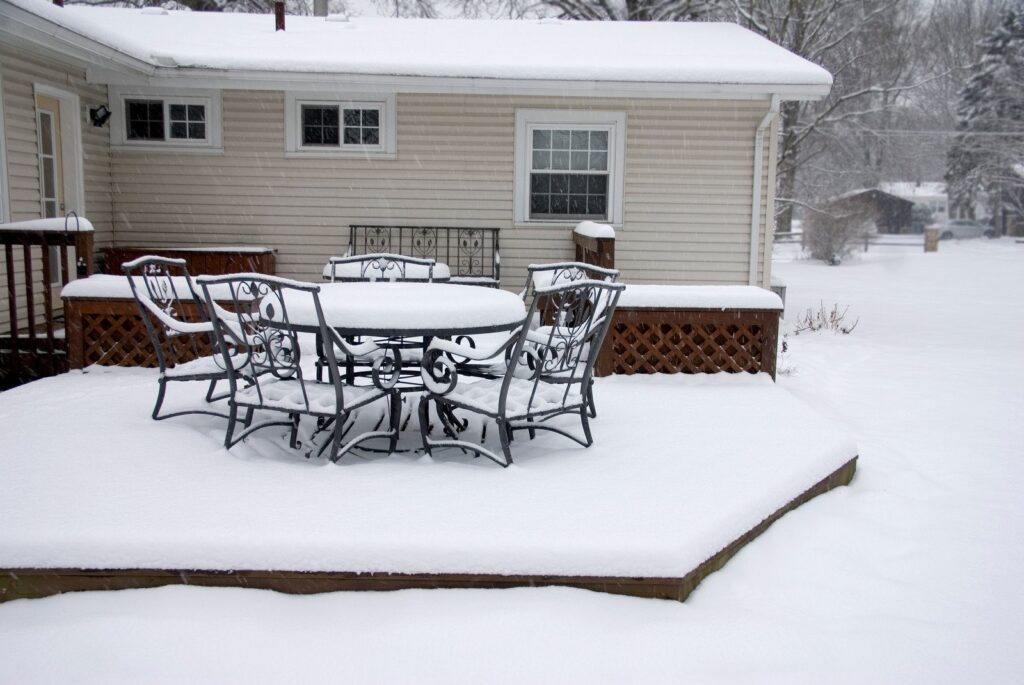Winterizing your deck is essential to guarantee its longevity and appearance come spring. By taking a few practical steps, you can protect it from harsh winter conditions. Start with a thorough cleaning to eliminate dirt and grime. Next, you'll want to inspect for any damages that need repair. But what's the best way to seal and protect your deck's surface for the season? Let's explore the necessary steps to keep your outdoor space in top shape. Before the winter chill sets in, it's crucial to clean your deck thoroughly to protect it from damage. Start by sweeping away debris like leaves and dirt, which can trap moisture. Next, employ effective deck cleaning techniques, such as power washing, to remove stubborn stains and mildew. If you prefer a gentler approach, consider using a soft-bristle brush along with eco-friendly cleaners. These cleaners not only safeguard your deck's finish but also minimize environmental impact. Be certain to follow the manufacturer's instructions for the best results. Once you've cleaned the surface, allow it to dry completely before applying any protective sealants. This thorough cleaning process will improve your deck's longevity and make sure it's ready to withstand winter's harsh conditions. Inspecting your deck for damage and making necessary repairs is vital to guarantee it can handle the winter weather. Start by checking all deck materials for signs of wear, such as cracks, rot, or loose boards. Pay extra attention to the structural integrity of supporting beams and joists, as any weakness here can lead to larger issues down the line. If you find any damaged areas, replace or repair them promptly to prevent further deterioration. Don't forget to check railings and stairs for stability, as these are essential for safety during icy conditions. Taking the time to address these concerns now will make certain your deck remains sturdy and safe for use when spring arrives. Once you've addressed any damage and made necessary repairs to your deck, your next step is to seal and protect the surface. Effective deck sealing techniques, such as applying a high-quality sealant, create a barrier against moisture, preventing rot and warping. Choose a product suitable for your deck material, whether wood or composite. Additionally, consider surface protection methods like using a waterproof tarp or breathable cover during winter months, which can shield your deck from snow and ice accumulation. Regularly reapply sealant according to the manufacturer's guidelines to maintain ideal protection. As winter approaches, it's essential to properly store or cover your outdoor furniture to protect it from harsh weather conditions. Start by cleaning your furniture thoroughly to remove dirt and debris, which can cause damage over time. If you have space, consider using furniture storage solutions like a shed or garage. This keeps your items safe and extends their lifespan. If indoor storage isn't an option, invest in high-quality protective covers. Make certain they're waterproof and UV-resistant to shield your furniture from moisture and fading. Secure the covers properly to prevent them from blowing away in strong winds. After securing your outdoor furniture, it's time to focus on snow and ice management for your deck. Proper snow removal is essential to prevent excess weight that could damage your structure. Use a plastic or rubber shovel to gently clear snow, avoiding metal tools that can scratch the surface. For ice prevention, consider applying a de-icing agent that's safe for your deck material. This helps to minimize ice buildup, making it easier to maintain traction. Inspect your deck regularly for any signs of moisture accumulation, as this could lead to more severe issues like rot. By taking these proactive steps, you'll guarantee your deck stays in excellent condition throughout winter and is ready for spring. You should winterize your deck annually, following a winterizing schedule that includes thorough inspections and maintenance. Regular upkeep prevents damage from harsh conditions, ensuring your deck remains in excellent shape for seasons to come. You can use a pressure washer for deck maintenance, but be cautious. High pressure can damage wood, so opt for a low setting and keep the nozzle at a safe distance to avoid splintering. For sealing your deck, consider high-quality sealing products like water-repellent stains or oil-based deck stains. These options provide excellent protection against moisture and UV damage, ensuring your deck stays beautiful and functional year-round. To prevent mold growth during winter, focus on moisture control. Guarantee proper drainage, clear debris, and consider applying a mold prevention treatment. Regularly check your deck to maintain a dry environment and inhibit mold development. Not all deck materials require winter care in the same way. For wood decks, proper maintenance is essential, while composite materials may need less attention. Assess your deck's material to determine the best winterization approach. By following these steps to winterize your deck, you're not just protecting your investment; you're ensuring it looks great come spring. A clean, well-maintained deck resists damage and lasts longer. Timely inspections and repairs prevent minor issues from becoming major headaches, while a quality sealant offers essential protection against moisture. Don't forget to secure your furniture and manage snow and ice to avoid structural harm. With a little effort now, you'll enjoy your outdoor space for years to come.
Key Takeaways
Clean Your Deck Thoroughly
Inspect for Damage and Make Repairs
Seal and Protect the Surface
Properly Store or Cover Outdoor Furniture
Prepare for Snow and Ice Management
Frequently Asked Questions
How Often Should I Winterize My Deck?
Can I Use a Pressure Washer on My Deck?
What Materials Are Best for Sealing My Deck?
How Can I Prevent Mold Growth During Winter?
Is It Necessary to Winterize All Deck Types?
Conclusion